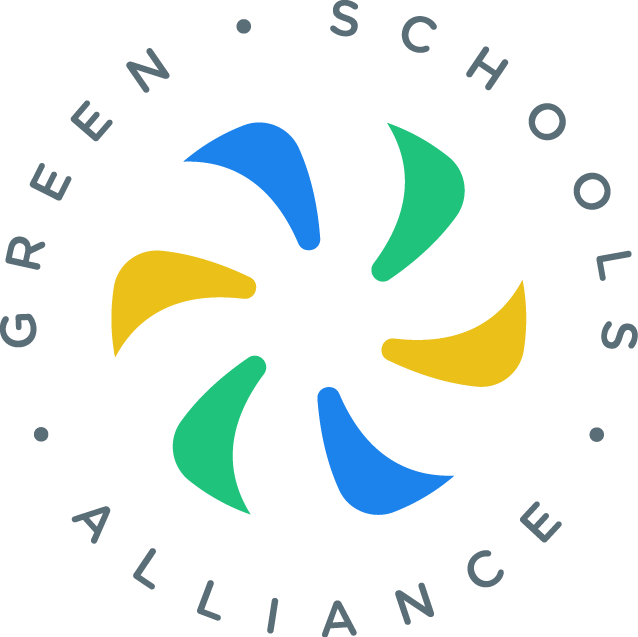How to Define your School’s Vision for Sustainability
"It was pretty clear from the beginning that I needed to get as many stakeholders as possible in a room and try to get a mission statement written."
- Tori Faye (Chadwick School)
Over three sessions the visioning team brainstormed three essential questions.
What should our priorities be? What do we care about?
After launching their vision into the school community, “it went wide… And it became a much bigger effort that is now fully encompassing the campus”.
Tori Faye had been campaigning for a formal Sustainability Coordinator position at her school, Chadwick School, for several years. Her persistence paid off when the position was finally established. Recognizing the need for a more unified approach to her school’s sustainability program, in the inaugural year in her new role Tori set out to collaboratively develop an aspirational mission statement for their school’s environmental sustainability – one that would not only define the school's sustainability goals, but also foster a sense of collective responsibility among stakeholders and drive momentum for action.
Initiating a Collaborative Missioning Process
Tori was aware that effective sustainability efforts required the involvement of a broad spectrum of the school community. Previously, the school's sustainability initiatives needed to be more cohesive, with efforts being led ad hoc manner and not fully integrated into the broader school community. To overcome this fragmentation, she sought to create a collaborative environment where various voices could contribute to shaping the school's sustainability mission.
"It was pretty clear from the beginning that I needed to get as many stakeholders as possible in a room and try to get a mission statement written." She began by reaching out to students, faculty, and staff, inviting anyone interested in sustainability to participate. Getting together the coalition took communication: “I spoke up at assemblies. I sent out email messages, to staff, faculty, and administrators, and said, if you're interested in this process, come; show up. The response was encouraging, with around 20 to 25 individuals forming a core group. “We met about once a month for eight or nine months. I found it to be a very powerful experience, and I'm so glad I had as diverse of a coalition as I did because I think it allowed us to get a lot of voices and a lot of perspectives in the final product.” This inclusive approach laid the groundwork for a shared vision.
Developing a Mission Statement
Tori approached the missioning process with a structured framework, posing key questions to guide discussions:
Who are we?
What do we do?
Why does it matter?
Over three meetings, Tori would put one of the big questions on the board, and, in mixed groups, they would brainstorm for a little while, share their ideas, and Tori would write their ideas on the board. “We spent a lot of time talking about the first question of: if we're doing sustainability, who are we as a community? Who does sustainability?” She wanted to refocus from the common challenge in sustainability work – where “everyone just wants you to solve their pet sustainability project" – to focusing more on broader objectives. Tori documented the ideas each session and then synthesized them into a cohesive idea. By the fourth meeting, she came back with, ‘Here's who we said we are. Here's what we said we do. And here's why we said it matters.”
When Tori came back to the group with more condensed information about their shared ideas, the group started to focus on how to phrase the school’s sustainability mission statement, how the ideas flow logically, and how to tie in the school’s existing mission statement and core values - which also helped to inform how they wanted to phrase their new sustainability mission statement. The iterative process involved refining the draft with feedback from the group, ensuring that the final document reflected a collective vision.
You can read Chadwick’s inspiring, aspirational vision statement here.
Defining Target Areas
From an aspirational vision to specifical goals
With a clear vision in place, the next step was identifying key target areas for their school’s sustainability. Tori pulled in examples from other schools and examined their own school's operations to define twelve target areas, such as transportation, education, waste and community outreach. The next task was to define a goal statement and a set of action items for each area. "We worked to try and say, okay, within those areas, what should our priorities be? What do we care about?" She set up small teams to focus on specific areas, who then brainstormed goals and action items.
Example:
ACADEMICS
Vision: We believe that every student on our campus should be exposed to sustainability themes and practices throughout their time at [our school]. We integrate sustainability into the curriculum in all grade levels, divisions, and departments and create experiential opportunities for students to interact with and learn from the natural environment.
Goal: Support and build opportunities to integrate sustainability into the curriculum through the use of lesson plans, field trips, class speakers/guests, and the garden program.
● ACTION: Support faculty in connecting sustainability topics with their curricula and activities.
Goal: Access off-campus sustainability expertise to help inform our community and efforts.
● ACTION: Develop a campus speaker series by 1) finding time on the calendar; 2) identifying speakers; 3) organizing the speaker series.
By following these steps—1) using the overarching Sustainability Vision as the guiding principle, 2) defining target areas, 3) establishing a vision for each area, 4) setting specific goals, and 5) outlining actions to achieve those goals—Chadwick’s sustainability visioning team transformed their aspirations into concrete steps, making real progress possible.
Introducing the Vision to the School Community
By the end of this process, Tori had a comprehensive document to present to the school administration. To her surprise, the administration embraced the ambitious goals. "I figured we were going to get thrown out of the room… I think it's radically optimistic as a mission statement," she remarked.
The school administration gave the green light to officially launch this vision into the community in January of 2022. “At that point, it went wide. We ended up with getting parent participation and it became a much bigger effort that is now fully encompassing the campus.”
Although the Visioning Committee disbanded at the end of this process, the document they collaboratively created has since been used to guide the school's sustainability efforts, and Tori still works with many of the members on a project-by-project basis. Tori regularly updates the leadership team and the broader school community on progress and plans. "Usually once a year we'll share, here is where we're at, these are our successes for the year," she explained. This transparency ensures that the school's sustainability initiatives remain a collective endeavor.
Conclusion
Tori Faye's experience underscores the importance of collaborative missioning in sustainability initiatives. By involving a diverse group of stakeholders and fostering open dialogue, she was able to create a comprehensive and aspirational mission statement that continues to guide the school's sustainability efforts. This case study serves as a valuable example for other institutions looking to implement or refine their sustainability programs.
To find further guidance and resources to create a sustainable vision for your school, join the GSA Community and explore The Sustainability Ignition Toolkit.





